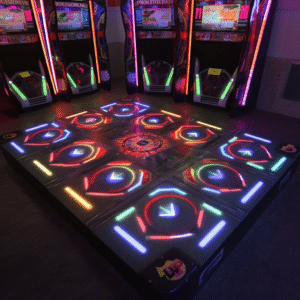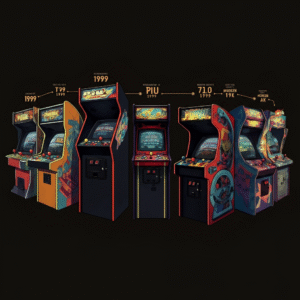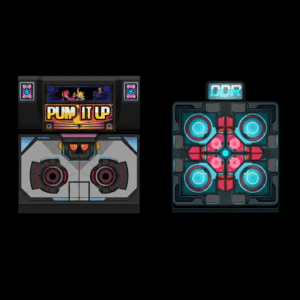
Introduction
A lively machine with a huge screen, heart-pounding music, and a distinctive five-panel dancing stage is probably what you’ll see if you go into any arcade with a serious rhythm game section. This is the setting for the Pump It Up PIU game. This thrilling dance game, which originated in South Korea, has enthralled players worldwide for more than 20 years. It’s more than simply a game; it’s a community worldwide, a physical challenge, and a way to express oneself.
The PIU game delivers a unique experience that distinguishes it from its competitors, despite the fact that some may view it as just another dancing machine. Pump It Up has established a devoted fan base thanks to its distinctive diagonal arrow design and extensive and difficult song repertoire. Every aspect of the PIU game, from its modest beginnings in 1999 to its most recent high-definition versions, will be covered in this extensive guide. We will examine its background, contrast it with its well-known competitor, Dance Dance Revolution, and provide you with the advice you need to begin your own PIU adventure.

What Exactly is the PIU Game?
The South Korean business Andamiro is the developer of the PIU music video game series. It is essentially a dancing simulation game in which players walk on lighted arrow panels on a dance pad that match to arrows that move up the screen. To get the maximum score, you must precisely synchronize your steps to the beat of a chosen song.
The five-panel design of the PIU game is what sets it apart. The PIU stage has four diagonal arrows (bottom-left, top-left, top-right, and bottom-right) and a central yellow panel, in contrast to the four cardinal directions seen in many other dancing games. The gameplay is drastically altered by this arrangement, which promotes more dynamic, full-body movement and a distinct stepping style. It seems more like real dancing because players have to strike the notes with crossovers, turns, and wide stances.
Key Features of the PIU Game:
- Five-Panel Pad: The iconic diagonal and center panel configuration is the defining feature. This allows for more complex and fluid step patterns, known as “charts.”
- Diverse Music Library: While heavily featuring K-pop, the game boasts a massive collection of original music from in-house artists like BanYa, Yahpp, and Msgoon. The genres span from pop and rock to heavy metal, jazz, and classical remixes.
- Difficulty Scaling: The PIU game is known for its incredibly high difficulty ceiling. Charts range from simple single-digit levels for beginners to notoriously complex charts rated 20 and above, which require immense stamina, speed, and technical precision.
- Freestyle and Technical Play: Historically, the game catered to both “freestyle” players, who incorporate breakdancing and stylish moves into their routines, and “technical” players, who focus on achieving perfect scores on difficult charts. While recent versions lean more toward technical play, the freestyle culture remains a vibrant part of the community.
- Advanced Modes: Players can engage in various modes, including “Doubles,” which uses all ten panels on both sides of the stage for a single player, and special modes like missions, nonstop courses, and online matching in newer versions.
The Rich History of the PIU Game
The journey of the PIU game began in South Korea on September 20, 1999, with the release of Pump It Up: The 1st Dance Floor. It quickly gained popularity in its home country, leading to a rapid succession of releases and updates.
Early Years and International Expansion
For the PIU game, the early 2000s were a pivotal time. Andamiro started its global push after a lawsuit and ultimate settlement with Dance Dance Revolution producer Konami. The game was first made available in North America, South America, and Europe with releases such as The Premiere: The International Dance Floor (2001). Although the game’s character remained firmly based in its original K-pop and BanYa tracks, which international players surprisingly enjoyed, this expansion temporarily placed a stronger emphasis on international music licenses.
With significant releases like Exceed, Zero, and the New Xenesis (NX) series, the series changed over the course of the decade. These iterations improved the gameplay and added new cabinet designs, such as widescreen LCDs. Pump It Up Zero added a new level of difficulty with their “Another” step charts, which provided unusual and experimental patterns for already-existing tunes. The NX series started to cater to high-level technical gamers by introducing the “World Tour” mission mode.
The Pro and Infinity Spin-Offs
Pump It Up Pro, a distinctive spin-off, was introduced in 2007 mainly for the North American market. This version was created by a group of people from the In the Groove community with the intention of appealing to 4-panel dancing game gamers. Along with additions like USB profile saving and a new charting style, it made use of a modified StepMania engine. The Pro series introduced many new players to the 5-panel concept and promoted goodwill, despite being different from the core PIU game lineage. Pro 2 and Pump It Up Infinity, which acted as a bridge and included music from all game versions, came after it.
The Modern Era: Fiesta, Prime, XX, and Phoenix
In honor of the game’s tenth anniversary, the Fiesta series launched the PIU game into the current era in the 2010s. The Prime series, the first to be available in 720p HD, came next. To mark the 20th anniversary, Pump It Up XX (pronounced “double-X”) debuted in 2019 and included contemporary elements including online matching.
We now arrive at the present generation. The summer of 2023 saw the debut of Pump It Up 2023 Phoenix, which had a fully redesigned scoring system (maximum score of 1,000,000), a new accuracy-based “plate” system, and a significant separation between Normal and Premium play modes. Pump It Up 2024 Phoenix, an update that continued to introduce new music and material to the platform, was released in May 2024. The PIU game has demonstrated a remarkable capacity for self-reinvention while maintaining its essential fundamentals.

Why is the PIU Game So Popular?
The enduring popularity of the PIU game can be attributed to several factors that create a deeply engaging and rewarding experience. It’s not just about hitting arrows; it’s about the culture, the challenge, and the community that surrounds the game.
The Appeal of Freestyle and Self-Expression
The PIU game has served as a medium for artistic expression since its debut. Complex dancing techniques are a perfect fit for the five-panel arrangement because of its larger stance and diagonal movements. Players developed a culture of “freestyling” in which they executed intricate, planned dances while still completing the necessary stages. This performance element draws break-dancers and dancers, transforming a video game session into an enthralling spectacle for spectators. Tournaments frequently have distinct sections for technical and freestyle performance, honoring both artistic ability and unadulterated talent.
An Incredibly High Skill Ceiling
The PIU game presents a seemingly insurmountable challenge for players that are competitive. The step charts, or “charts,” are significantly more complex than the majority of onlookers can understand. Superhuman endurance, extraordinary foot speed, intricate pattern recognition, and exact timing are all necessary for high-level charting.
The hardest charts are currently in the mid 20s, and songs are scored on a number scale. A “Double Performance” chart employs all 10 panels for a single player, whereas a “Single Performance” chart uses the five panels on one side. Only the world’s best players are able to clear, let alone score highly on, a level 25+ Double chart. For committed players who spend years perfecting their talents, this enormous task serves as a potent motivator. A major component of the game’s appeal is the sensation of eventually passing a chart that previously seemed unachievable.
A Strong and Passionate Global Community
The PIU game has created a close-knit community around the world. Players bond both in-person and virtually, exchanging strategies, scores, and a shared love of the game. PIU gaming cabinets at arcades frequently become into gathering places for gamers to interact, compete, and encourage one another.
Events organized by fans and by the organization itself support this sense of community. The World Pump Festival (WPF), a worldwide competition that brings together the top players from various nations to vie for the title of world champion, was organized by Andamiro. These gatherings honor the game’s global fan base and demonstrate its standing as a respectable sport.

PIU Game vs. DDR: A Tale of Two Titans
For many, the first point of comparison for any dance game is Konami’s Dance Dance Revolution (DDR). While both are giants of the rhythm game genre, the PIU game and DDR offer fundamentally different experiences.
Gameplay Mechanics: Diagonals vs. Cardinals
The most obvious difference lies in the dance pads. DDR uses a four-panel layout with arrows pointing up, down, left, and right. The PIU game uses five panels: four diagonals and a center button.
- DDR’s Gameplay: The cardinal layout promotes more rigid, front-facing movement. Footwork is often about quick taps and keeping your body centered. While high-level DDR is incredibly fast and complex, the range of motion is generally more contained.
- PIU’s Gameplay: The diagonal layout requires players to twist their hips and cross their legs to hit notes. The center panel acts as a pivot point and an extra step, breaking up patterns and forcing players to reset their position. This results in a more flowing, dance-like movement that utilizes more of the player’s body. Double charts in the PIU game often feel like a full-body workout that tests coordination across a wide space.
Audience and Cultural Impact
Both games have passionate communities, but they have evolved with slightly different focuses.
- DDR’s Focus: DDR has a massive legacy and is often seen as the more “mainstream” of the two, with a greater emphasis on licensed pop music, particularly from Japan (J-pop). Its scoring system has traditionally been more combo-focused.
- PIU’s Focus: The PIU game has cultivated a more niche but intensely dedicated following. Its music library, with its unique K-pop and original compositions, gives it a distinct flavor. The community is often celebrated for its dual embrace of high-level technical skill and creative freestyle performance. The difficulty ceiling in the PIU game is widely considered to be higher and more focused on stamina and complex patterns than raw speed, though both games require all three at elite levels.
Ultimately, the choice between the PIU game and DDR comes down to personal preference. They are not simply copies of one another but two unique disciplines within the same sport. Many players enjoy both, appreciating the different skills each one demands.

How to Start Playing the PIU Game: A Beginner’s Guide
Are you ready to step onto the five-panel stage? Starting your journey with the PIU game is exciting, but it can be intimidating. Here’s a simple guide to get you started.
Your First Game
- Find a Machine: Locate an arcade near you that has a Pump It Up machine. Newer versions like Phoenix are ideal, but any version will do.
- Insert Credits and Select Your Mode: Modern machines offer “Normal Mode” and “Premium Mode.” Start with Normal. You’ll likely be asked to choose between Single (5 panels) or Double (10 panels). Stick with Single for now.
- Pick a Song: The song list can be overwhelming. Look for songs with low difficulty ratings (Levels 1-5). Most versions have a “Basic Mode” or allow sorting by difficulty. Don’t be a hero on your first try! Songs like “(G)I-DLE – Queencard” or “BanYa – Beethoven Virus” on their easiest charts are great starting points.
- Understand the Arrows: Arrows scroll from the bottom of the screen to the top. When an arrow overlaps with the stationary guide arrows at the top, that’s your cue to step on the corresponding panel.
- Watch Your Feet (and the Screen): Your natural instinct might be to look down at your feet. Try to keep your eyes on the screen to see what’s coming next. Your body will learn where the panels are with practice.
- Don’t Worry About Your Score: Your first few games are about getting a feel for the rhythm and the panel layout. Just have fun and try to finish the song.

Tips for Transitioning from DDR to PIU
If you have a background in 4-panel games like DDR, you have a head start in timing and rhythm. However, the PIU layout requires some adjustment.
- Embrace the Center Panel: The center panel is your home base. After hitting a diagonal arrow, you’ll often return your foot to the center.
- Learn to “Twist”: You can’t face forward all the time. Hitting opposite diagonals (e.g., top-left then bottom-right) requires you to pivot and twist your body.
- Crossovers are Key: You will have to cross one foot over the other. Don’t be afraid of it. This is a fundamental technique in the PIU game.
- Start Slow: Even if you can clear difficult DDR songs, start on low-level PIU charts. Your muscle memory needs to adapt to the new layout and movement patterns.
The Future of the PIU Game
The PIU game hasn’t slowed down in over twenty-five years. As evidenced by the recent release of Pump It Up 2024 Phoenix, Andamiro is dedicated to preserving and improving the arcade experience. Additionally, the business has expanded into other areas.
An important step has been taken with the announcement of Pump It Up Rise for PC (via Steam). A home version would make the PIU game available to a large number of people who might not otherwise have access to an arcade. In addition to opening up new channels for competition and content production, this might encourage an even bigger online community.
Future versions of the PIU game should continue to incorporate online elements, possibly extending online leaderboards and matching. Even the most seasoned professionals will always have a new obstacle to overcome as step chart design innovations continue to push the limits of what is feasible on the 5-panel stage.

Conclusion: Take the First Step
There is something for everyone in the rich and fulfilling PIU game. Pump It Up is a great option for competitive gamers seeking a challenge, fitness enthusiasts seeking an exciting and challenging workout, and dancers seeking a new form of self-expression. It’s a game that challenges your physical and mental abilities, rewards commitment, and links you with an enthusiastic global player community.
The PIU game has solidified its position in arcade history with its distinctive five-panel design, memorable music, legendary difficulty, and lively culture. However, it is not merely a relic of the past; rather, it is a dynamic platform that keeps changing and thrilling. Don’t simply pass by that shining cabinet the next time you see it. Take a step forward, add a credit, and allow the beat to guide you. You’re only a step away from starting your PIU game trip.





Leave a Reply